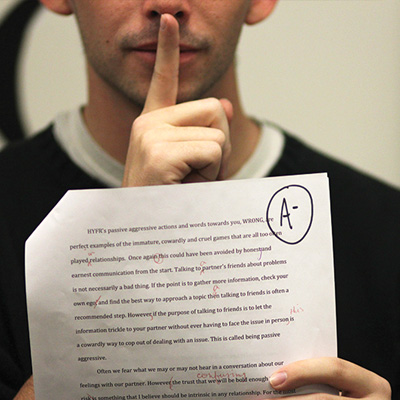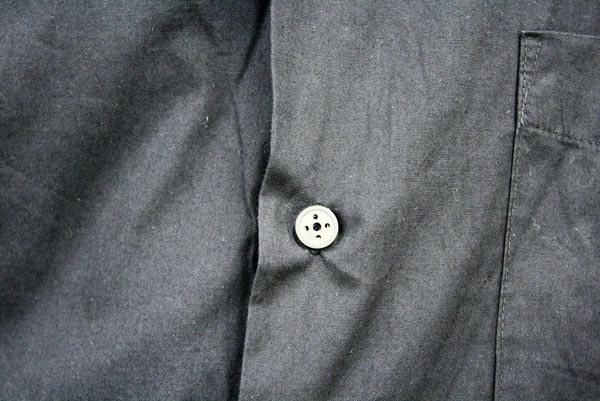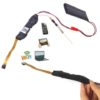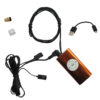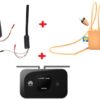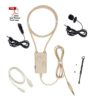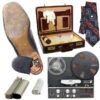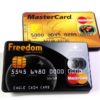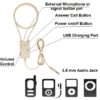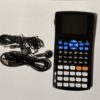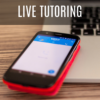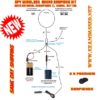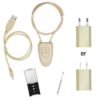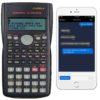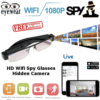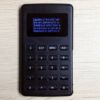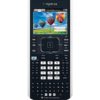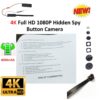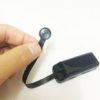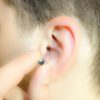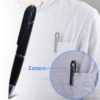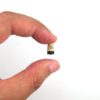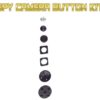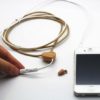Whoever said cheaters never prosper forgot to text the message to the current generation of students. According to a 2010 study conducted by Rutgers University, 64% of college students have cheated on tests. In 2009, global research firm, the Benenson Strategy Group, conducted a poll which found almost one-in-three middle school and high school students have cheated on a test using their mobile phone; over half said they’ve used the Internet to cheat in some capacity. What’s more, one-in-four students said they didn’t see anything wrong with using technology to cheat. Seems times have changed.
While cheat sheets written on sheathes of dead bark are still used to help students get an upper hand on exams, kids are increasingly turning to more technological means to get over on their teachers. Recently, schools have been catching up, getting hip to the many ways students can use their gadgets to cheat. Is cheating right? No, not really. Is it risky? Yes, very. If you get caught cheating the consequences are now very severe. Is that going to stop us from exploring the multitude of high and low-tech ways you can trick your way to an A? Nope, not in the least. Before we get into it, though, let us be clear: COMPLEX does not condone nor promote the act of academic cheating. Try these tips at your own risk. With that out of the way, let’s get to the 50 Ways Technology Can Help You Cheat in School.
The Earpiece Method
What you need: any Spy Earpiece kit from https://topspygadgets.com
Risk level: Low
Get your Mission Impossible on with this discrete method of cheating. There are a number of companies that make tiny earpieces, but only a few of them can work with such a wide array of applications. Connect the MWE Spy earpiece to your phone via Bluetooth and have your friends feed you facts. Or you can go a little safer with the MP3 version which lets you listen to audio files thanks to a transmitter that plugs into your audio player. It’s pricey, yes—but if you really need to pass an exam, this is one of your best, most fool-proof bets.
The Bathroom iPod Method
What you need: MP3 player
Risk level: Low
Pretty straight forward and simple: Before your exam, load your MP3 with audio notes and store it in a bathroom near your exam room. After parsing the entire exam and figuring out what you don’t know, take your one bathroom break, listen to the parts needed, and head back to class. Try to keep the smirk off your face, though.
The Texting Friends Method
What you need: Mobile phone
Risk level: High
If you think you got balls (or the gall) you can attempt to text your friends—who should be waiting back at your bunker of a dorm room in front of a computer—to get help with certain questions. We recommend developing some sort of shorthand that would be easy to quickly type so you’re not caught typing entire messages to your friends.
The Graphing Calculator Method
Photo Removed
What you need: Scientific calculator
Risk level: Medium
This may be the oldest high-tech cheating method. This tip is primarily for cheating on some sort of math or science exam where equations and theorem are needed. As you know, graphing calculators are able to store equations and other information for later use. You can use this function, of course, to store data that you need to pass your test. Here’s how you do it.
Press Program, select “New”, then press “Enter”
Name the new program whatever you want. The keys will automatically be in alpha mode.
Type in your formulas
To read the notes/programs, go to “Edit” and select the appropriate one.
Most teachers will walk around and erase the memory from your calculator to avoid this sort of thing. However, if you press the “2nd” key, then the “+” key (it’s the memory button), then go to “All,” you’ll your note/program. Once you find them, hit “Enter”. An asterisk will appear next to it. This means it’s safe. After the teacher erases your memory, go back to that menu and viola!
The Google Method
What you need:Smartphone with web browser, data plan
Risk level: High
We hear you snickering and rolling your eyes; we see you, too, about to click out of this story, but you’d be surprised how many students have done the ol’ “Let me Google this answer right quick” trick and had it work. It will only work about two times during an exam (if that), so use this wisely. We recommend bookmarking a few sites that you know will be of use to you while taking your test so you don’t have to bother with typing in an URL.
The MP3 Lyrics Method
What you need: exam cheat MP3
Risk levels: Medium
This tip may be more trouble than it’s worth, but here you go. In the newer versions of iTunes, you can add lyrics to an audio file. If you put the audio file onto your iPod Touch (or iPhone) and play it, you can have the lyrics scroll down the screen while the song is playing. Instead of lyrics, you can put in whatever text you’d like. If, for some reason, you can manage to take a look at your iPod Touch or iPhone while taking your exam, you can play a song and look at the text your added to the file.
The Headphone in Sleeve Method
What you need: MP3 player, headphones, long-sleeve shirt
Risk level: Medium
Can’t afford to buy a high-tech miniature earpiece? Don’t fret, you can still cheat using pre-recorded audio. All you need to do is position the MP3 player somewhere out of sight—say, your pocket—and run one of the headphones up one of your sleeves with the earpiece stopping right at your cuff. While taking your test you simply rest your head on your hand, hit play, and listen to your audio notes. We recommend you do this one in short bursts.
The Smartphone Notes App Method
What you need: Smartphone, a notes app
Risk level: Medium
When you think of cheating with technology, this, more than likely, is what comes to mind. Nothing fancy about this method: You gather the info you need for you exam and enter it into the notes app found on your phone. Every smartphone has a notes app—even the cheap ones you can get for free from Walmart. While taking the test, sneak your phone out and peep your notes without getting caught. Done and done.
The Online Paper Method
What you need: Money, web browser
Risk level: High
Websites selling papers have been around since the Internet existed. For that reason, schools and institutions have cracked down hard on the practice. Entire industries have been birthed to combat plagiarism and the purchasing of papers. Buying a paper from a website can bite you in the ass as many sellers push the same paper to multiple students, making it easy for teachers to track it down and catch you. That said, if you don’t have the chops nor the time to write your own paper, and you can’t find a kid on campus willing to do it, it’s still an option. Not one of the best options, but an option nonetheless. Or you can find a tutor here http://live-exam.com/
The Mechanical Pencil Method
What you need: Bic Mechanical Pencils, $5; Printer
Risk level: Low
There are plenty of ways you can sneak a cheat sheet into your exam (there are more on this list); one of the best is in a mechanical pencil. After you type up your miniature cheat sheet, grab a non-see-through mechanical pencil that takes 0.7mm lead or thicker, remove the eraser, remove all but one of the pieces of lead, roll up the cheat sheet and stuff it in the barrel. During the test, when the one piece of lead runs out, act like you’re putting more in and take a peek at your cheat sheet. Discretely, of course.
The Mobile Phone Picture Method
What you need: Mobile with built-in camera
Risk level: High
Ever heard of taking one for the team? This is what you’ll be doing with this method, as this tips is more for the benefit of your friends than yourself. We’re going to go ahead and recommend that you actually study (Gasp! What?!) before attempting this. It’s simple, really. Before you head into your exam, have your camera already loaded and ready to go (some cameras take forever to load). While taking the test, snap a pic of each page to send back to your crew. Remember: Ain’t no fun if the homies can’t get none.
The High-Tech Sunglasses Method
What you need: HD PSY GLASSES
Risk level: Low (if you’re able to wear ’em), otherwise High
We’ve never been able to rock sunglasses during an exam, but if you can find a way, you’re golden. Maybe you can get a fake doctor’s note saying your have some sort of eye condition. Anyway, if you do get to wear shades in class, you should wear the Oakley Thump 2. The Lil Jon-endorsed eyewear has a built-in MP3 player with 512mb of storage that will allow you to upload your pre-recorded audio notes and listen during your test. You will look like a complete jackass, but if you can pull it off, it’s completely worth the sartorial sacrifice.
The Virtual Keyboard Method
What you need: Celluon LaseryKey CL850 Bluetooth Virtual Keyboard
Risk level: High
So, out of all your boys, you’re the first one taking the test you all have to take. What do you do? Share the wealth. We already went over texting test questions to your friends, but whipping our your phone to send a text is difficult to do during an exam. A slightly less abrasive method would be to get a virtual keyboard attachment for your phone. The Celluon LaserKey projects a laser keyboard onto your desk so you can quickly type away like on a real keyboard. If you have a seat in the back of the room, it just may work.
The Calculator Watch Method
What you need: Casio DBC15-1 DataBank Calculator Watch (or similar)
Risk level: Low
Very few teachers will make you check your watch at the door. So, naturally, you should take advantage of this oversight. Though not as prevalent in the market as they once were, calculator watches can still be found online or at some RadioShacks or American Apparels. Besides offering you a calculator, watches like the Casio DBC15-1 DataBank gives you 150 pages for you to do whatever you want. Granted typing all your notes into a wrist watch will take a couple episodes of Curb, but it’s worth it.
The Coke Bottle Method
What you need: Scanner and printer; Kodak ESP C310 All-in-One Printer, glue stick
Risk level: Low
There are some methods of cheating that are more difficult and time consuming than sitting down in a library and studying. This is one of them. If you’re handy with photoshop, you can take the label from a Coke bottle, scan it into your computer, and replace the text with your notes. Most professors and teachers allow you bring a beverage to the exam, so it shouldn’t seem too conspicuous. However, just to be safe, we’d probably go with a bottle of water or even a bottle of Vitamin Water which already has a gang of text on its label.
Carefully peel label off of bottle. Be mindful of not creasing it too much as that will affect the reproduction.
Scan the label into your computer at the highest possible resolution. Anything over 600 dpi will be fine.
Use Photoshop (or your preferred image editor) to remove the text. This can be done using the clone tool.
Type in your notes. Make sure to try your best to match the font, color, and size of the text you removed.
Print the new label on glossy photo paper and cut it out. Make sure the size of the print out perfectly matches the original label.
Carefully glue the new label onto the bottle.
The Rubber Band Method
What you need: Rubber Bands; Alliance Sterling Ergonomically Correct Rubber Bands .25” x 3.5”
Risk level: Low
One of the most low-tech tips on this list, the rubber band method is also one of the simplest. For this trick, you need to make sure the rubber bands are thick enough for you to properly write notes on. We recommend ones at least .25” thick.
Take a rubber band and stretch it over one of your text books.
While stretched out, take a ball point pen and write out your notes. Make sure the text is written closely together; not to the point where you can’t make it out, but not super-stretched out.
Let the rubber band shrink back to its original size.
Wear it to the exam. The text will look like black blotches. When you need to peek at your notes, stretch it out.
The Tiny Booklet Method
What you need: Word processing software, printer, stapler
Risk level: Medium
This method is nothing new. People have been making cheat booklets since before Pimpin’ was pimpin’. Students tend to prefer to write these booklets out by hand. Not us. Using even a basic word processor program (we’re using Microsoft Word), you can cram in a large amount of info into.
Set the font in Word to the smallest you will be able to read. For most people it’s “8 pt”
Set the margins to 1.5 inches
Write your notes in four line paragraphs. Each ‘graph will be a page.
Print the notes out and cut out the paragraphs.
Staple them together.
The Eye-Fi Method
What you need: Digital camera, Eye-Fi X2
Risk level: High
These days, more and more cameras come equipped with Wi-Fi so you can wirelessly send images to a printer or a friend’s e-mail. Have an old digital camera? Don’t worry, you can do the same with an Eye-Fi card. If you can manage to snap a picture of your exam using your digital camera, you can send the images directly to your friend’s phones or e-mail, or even to a Wi-Fi enabled printer. Of course, you can do the same with your phone.
The MP3 Pen Method
What you need: Geek Pen,
Risk level: Medium
If sneaking in your audio notes is a top priority, you should try a MP3 Pen. It’s just what it sounds like: a pen that can play audio files. The quality is not the best, and it’s not the most comfortable writing utensil, but unlike other multi-purpose pens, this one actually looks like a pen, which will help when getting it past your proctor. The only downside: there is no built-in speaker, you will need to use a pair of headphones. We suggest you combine an MP3 Pen with a Spy Headset.
The Paper Length Method
What you need: Word processor software
Risk level: Low
Having a bit of trouble filling out the 10-page paper due in a few hours? Mess with the aesthetics. Traditionally, if students wanted to add length to their papers, they would increase the size of the margins and fonts, but that very rarely works. A more subtle way of lengthening your paper is to change the size of the periods. It’s easy:
In Microsoft Word, go to the “Edit” pull down menu and click “Find”
Go to the “Replace” tab. You will see two text boxes: Enter “.” into both of them.
Go to “More” and select the period in the second text box
Click the “Format” pull-down menu and click “Font”
Select font size “14” and click OK.
Click “Replace All”
Your paper will jump at least a half-page in length. The longer your paper (the more periods), the more it will grow.
The Facebook Method
What you need: A Facebook account
Risk level: Low
More than likely, you’ve already used Facebook to cheat without even knowing it. Or maybe you did. After locating all the students taking the same class as you (or that have taken the class), form a Facebook group and invite them all to join. From there, you pick everyone’s brain and try to get some of the members to come up off some test answers.
The Laser Pen Method
What you need: Wacom Inkling
Risk level: High
The Wacom Inkling is a device that allows you to transmit your pen strokes to your computer. Many will use it to transfer their analog drawings into the digital world, but you can use it to bring your answers to your friends after you take a test. The only hinderance is the receiver that needs to be clipped onto your paper. It may be a tad difficult to explain that one to a professor.
The Spy Glasses Method
What you need: Spy Glasses
Risk level: Low
We’ve went over a few ways for you to hip your friends to what they’re going to encounter on a test, but this may be the easiest one yet. ZionEyez glasses feature a built in video recorder so you can wirelessly capture everything on the exam without anyone being the wiser. And unlike a lot of other “spy glasses”, ZionEyez allow you to switch out the sun glasses lenses for less conspicuous clear ones.
The MP3 Text Message Method
What you need: Handcent app, Free
Risk level: Medium
Lets say you forgot to prepare your audio notes for the exam and you feel like you’re S.O.L. If you have an Android phone or iPhone that doesn’t have to be the case. A free messaging app called Handcent allows friends to text you just about anything: images, documents, and large audio files.
The Electronic Dictionary Method
What you need: Electronic Pocket Dictionary; Sharp PW-E550 Electronic Dictionary
Risk level: Low
Similar to graphing calculators, electronic dictionaries are one of the few devices you’re allowed to bring with you to an exam. Use that to your advantage. Most models have a small amount of memory, but allow you to keep a limited number of notes on the device. Figure out which notes are most important to you, type them into the device, and go to your exam. The only hang-up: Some schools only allow certain types of electronic dictionaries, some of which may not have a notes feature.
The Desk Speaker Method
What you need: Origaudio Rock-It
Risk level: High
This is the most risky tip on this list. The Rock-It is a device that can turn any object into a speaker—books, boxes, cups, it doesn’t matter. Hollow objects work better. The Rock-It turns your music into vibrations which it sends via its Rock-It Pod to whatever it’s attached to. With your audio notes loaded onto your MP3 player, you can discretely connect it to the Rock-It which will then turn your desk into a speaker. Keep the volume low, and put your head on your desk for a quick listen.
The Invisible Ink Method
What you need: Invisible ink pen
Risk level: High
To pull this off, you will have to know exactly where you will be sitting during your exam. If you can secure that, the rest is relatively easy. Using the invisible ink, write your cheats on your desk the night before the exam. You want to make sure you write it after the cleaning crew has made its rounds. On test day, whip out a mini UV light (preferably one that connects to your keychain) and read your notes. Or, you can write your notes on a piece of paper using invisible ink and bring with you to the exam. Whichever is easier for you, homie.
The Eraser Method
What you need: Rubber eraser, X-Acto Knife
Risk level: Medium
One of the most unassuming ways to bring your paper notes to an exam, the eraser method is relatively simple. Measure your paper note and mark two points on your eraser slightly larger than the note. Using the X-Acto Knife, cut out a portion as wide as the marks and as thin as half the eraser. Now, you can place the note into the erase, put the piece you cut out back on, and go about your day. Not very high-tech, but it’s been known to work.
The Picture Method
What you need: Smartphone with built-in camera
Risk level: High
Very simple: Take a picture of your notes using your smartphone and pull them up on the day of the test. Not very slick, but you don’t get caught, it can be very effective.
The Blank Paper Method
What you need: Looseleaf paper, pencil, eraser
Risk level: Medium
This method is not very technical at all, but it was too good to leave out. When writing your notes, place a piece of paper beneath it and write as hard as you can so each letter is imprinted into the next page. When you start your exam, take a pencil and lightly shade over the text. You should be able to see the notes. When finished, erase the page.
The Gum Wrapper Method
What you need: pack of Wrigley’s gum (any flavor/brand), Word processor software, printer.
Risk level: Low/Medium
Some schools ban gum during tests, but most don’t. For this tip, you need to get a pack of the five-stick Wrigley gum—the kind that has the gum individually wrapped and used to cost 25 cents, but not costs 35 (smh). From there:
Print out a very small—tiny, really—cheat sheet
Take out a stick of gum and unwrap it
Wrap the cheat sheet around the stick of gum, then put the wrapper back on and place it in back into the pack.
When at your exam, take out the stick, chew the gum, and take a look at your notes.
The Tie or Skirt Method
What you need: Word processor software, printer, tape, Tie (Guy), Skirt (Girl)
Risk level: Medium
For this co-ed tip, all you have to do is print out your cheat sheet in small paper squares (Guys should make them smaller, and more rectangular than the girls’). Once printed, line up the square sheets and tape them together in a row. Girls: Find the skirt you’re going to wear on test day and tape the row of sheets to the inside of the skirt’s hem, or slide them under your stockings. Guys: Find the tie you will be wearing on test day and tape the row of sheets to the back of your tie. Both should make sure the text is pasted upside down. While taking the test, girls, flip the skirt up a little, and guys slightly turn your tie around, and quickly peep your cheat sheets.
The CalcPad App Method
What you need: Apple iPhone, CalcPad App.
Risk level: Medium
Convincing your professor or teacher to let you use your iPhone as a calculator will more than likely end up with him or her telling you FOH! However, on the off chance that your teacher is cool with you using your smartphone as a calculator, we recommend using the CalcPad app. On top of being a calculator, CalcPad lets you store notes and even surf the Web.
The iPod Notes Method
What you need: iPod Classic
Risk level: Medium
Getting your iPhone or iPod Touch past your teacher or professor is going to be difficult. However, it should be slightly less difficult to get an older iPod into your exam room, due to the fact that they can’t connect to the Internet. But while the old iPods can’t log on to Twitter, they can store notes.
Connect your iPod to your computer
When your iPod appears as a drive in your Finder (Mac) or in your Explorer (Windows) click on it and go into the “Notes” folder.
Find your notes text file (your notes should be saved as a Rich Text File)
Drag it to the “Notes” folder on your iPod.
Disconnect your iPod
Your note will be found in the “Notes” folder under “Extras”
The Rear View Glasses Method
What you need: Rear View Spy Sunglasses
Risk Level: High
This tip requires two people: One person who either knows the material on the exam or is cheating, and the person looking back at that person. Of course, this method is relying on the fact that your proctor will let you wear sun glasses while taking test. But if they do, you have your friend take the test behind you while covertly signaling the answers to you. It’d help if the two of you set up an easy code beforehand.
The Calculator or Phone Case Method
What you need: Graphing calculator or Smartphone with case
Risk level: Medium
This is one of the most blatant methods, but it has been known to work in low-stress situations. Prepare your cheat sheet and before you go to your exam, slip it in the case of your phone or graphing calculator. Done and done.
The Clear Pen Method
What you need: Pentel R.S.V.P., word processor, printer
Risk level: Medium
You can use any pen you want for this cheat as long as the body is clear and there’s an easy way to get inside of it. We prefer Pentel’s R.S.V.P. because they’re comfortable to write with, they come with a screw top, and the ink is removable.
Print a cheat sheet using very small font, 7 or 8 pt should work fine.
Open the pen and, if you can, remove the ink.
Tape the cheat sheet to the inside of the pen with the text facing outwards so you can read it.
The Key Chain Camera Method
What you need: KCDVR Key Chain Camera DVR
Risk level: Low
If spy glasses aren’t your style, you can still sneak in some snap shots with a miniature camera. There are plenty on the market, but we recommend copping the KCDVR Key Chain Camera. As its name suggests, it can fit on your keychain and can record video and take still photographs. And since it looks like the remote for a car alarm, we doubt it will set off alarms with any professors or proctors.
The Wikipedia Method
What you need: Apple iPhone; Wikipanion app, Free
Risk level: High
Despite studies showing that Wikipedia is nearly as accurate as commercial encyclopedias, professors, and teachers would still prefer you not use The Free Encyclopedia when studying or writing reports. We say heed their warning and follow the rules. For those of you iPhone owners writing a report from Wikipedia while you read this, download the Wikipanion app. With full-page search, the option to bookmark articles and certain portions of articles, it’s perfect for quickly referencing info when writing a report or taking a quiz.
The Evernote Method
What you need: Apple iPhone, Android device; Evernote app, Free
Risk level: Low
Evernote is one of the best, if not the best, productivity apps available for the iOS and Android platforms. It effortlessly syncs all your documents between your smartphone and computer; it can even analyze text from images and make it searchable. It’s great for students looking to stay organized… and cheat. Don’t scramble the night before an exam to get your cheat sheet tight. Develop it over the course of the class by keeping it updated no matter where you are. On test day, you’ll have a fully curated cheat sheet right there on your phone.
The Lecture Method
What you need: Digital audio recorder; Olympus VN-801PC
Risk level: Medium
A number of professors base their tests directly on the lectures that precede them. If you find your professor to be of that sort, recording his or her lectures to later study would be wise. However, considering the nature of this list, we’ll say that it’ll also be wise to sneak a tiny voice recorder into your exam room and weave a headphone up your sleeve to listen to the bits of the lecture that you left an index mark on. Oh, ‘cause with the Olympus VN-801PC you can do that.
The Collective Method
What you need: Corkboard.me
Risk level: Low
The truth of the matter is that tests change from year to year. Very few teachers administer the same exam year after year. What doesn’t change is the information they teach and test you on. If you’re able to find people who’ve taken a class before you, you can set up a public “message board” of sorts where everyone can contribute to a major cheat sheet. We recommend using the digital whiteboard on Corkboard.me. Share the link and watch as people add on the bits and pieces of info they think is pertinent for you to pass. Power to the people.
The Light Ink Method
What you need: Printer
Risk level: Medium
The best place to hide your cheat sheet, if possible, is in plain sight. The best way to do this is by printing your cheat sheet using a light-colored ink. Yellows, pale pinks, and light browns will all work well. Just make sure you’re able to read it without strongly squinting once it’s printed.
The Bait and Switch Method
What you need: Scanner, printer
Risk level: High
It doesn’t happen as much as we’d all like it to, but there are rare occasions when students get access to the test before the day of the exam. If you’re one of the lucky few to be the beneficiary of this largesse from the scholastic gods, take the exam, scan it, and print out a copy. Fill in the answers and bring the exam with you on test day. Pretend as if you’re filling out the test, and switch it with the pre-prepared one before the proctor collects the papers. If done correctly, no one will be the wiser.
The Bluetooth Watch Method
What you need: Bluetooth-enabled watch; Citizen i:VIRT M, Sony Ericsson LiveView, Pebble Watch.
Risk level: Low
Admittedly, checking your mobile phone during an exam is very tricky business. Checking your watch, on the other hand, is not. Though pricey, a Bluetooth-enabled watch is one of your best bets for receiving text messages from your friends while taking your exam. Citizen Japan’s latest Bluetooth watch lets you check e-mail and text messages directly from the watch. Sony Ericsson’s LiveView does the same at a cheaper price, but looks like an iPod Nano attached to a wristband. Warning: You may get hemmed up for rolling into class with what looks like an MP3 player on your wrist.
The Scroll Pen Method
What you need: Scroll pen; Jac Zagoory Scroll Pen
Risk level: High
There are ways for you to concoct a pen-based set-up where you attach a sheet of paper somewhere onto the shaft or cap of a pen (or mechanical pencil), but that may be too much prep for some of you. For an easier route, there are scroll pens: pens with rolls of paper built-in. It’s not necessarily high-tech, but it’s a very handy gizmo. Jot down your notes onto the ribbon of paper before you load it into the pen, then pull it out as needed during the exam. Make sure the pen you choose looks like as close to a regular pen as possible.
The Calculator Belt Buckle Method
What you need: Chrome Calculator Belt Buckle.
Risk level: High
We usually wouldn’t recommend wearing any belt buckle as gaudy and geeky as this. That said, if you’re in a math class with a teacher prone to hitting you with quizzes and tests where calculators are banned, this buckle made of a simple calculator may become a wardrobe staple.
The T-Shirt Method
What you need: Science Crib Sheet T-Shirt, U.S. History Cheat Shirt.
Risk level: High
This tip is neither high-tech or high fashion—but all geeky. Companies like Snorg Tees and Computer Gear have taken to making t-shirts scribbled with formulas, dates, and important terms you may come across during your scholastic career. The U.S. History Cheat Shirt has its text and diagrams printed upside down for easy reading. Your professor or teacher will have to be extremely dense to let this one slide, but it’s worth a shot. What are they going to do? Tell you to go home and change? Well, yes, they very well may.
The Bookmark Method
What you need: Printer, Adobe Photoshop (or image editing software), laminator
Risk level: Medium
When teachers tell you not to bring anything to a test, the one thing you can usually tote along is a book for you to read in the event you finish early. Take advantage of this opportunity by making a custom bookmark with your cheat sheet printed on some part of it. We recommend putting a bold design on one side, and the information you need on the other. You want to make it look like a real bookmark, so if you can get access to a laminator, the better off you’ll be. Don’t make it too large: 1-inch wide and five inches long is a good size. While you’re taking your test, slide it out and glean as much as you can.
The Studying Method
While it’s fun to joke around about the many ways we can decieve the powers that be to get an educational edge-up, cheating is not a game. As we said earlier, if you get caught the consequences can be dire. Institutions have been cracking down on cheating over the last decade, taking exteme steps to ensure that students are actually learning (or, at the least, remembering) the information they’re being tested on.
Outside of the judicial ramifications that can come from cheating, you’re shortchanging yourself. Sounds corny, we know, but straight up: if you don’t even study the stuff you’re being taught you’re setting youself up for failure. And if you’re in college and you’re cheating, you’re also cheating yourself out of thousands of dollars.
Of course, the rub is that in the course of attempting one of these methods, you’ll probably learn all the stuff you’ve been neglecting and refusing to study.






